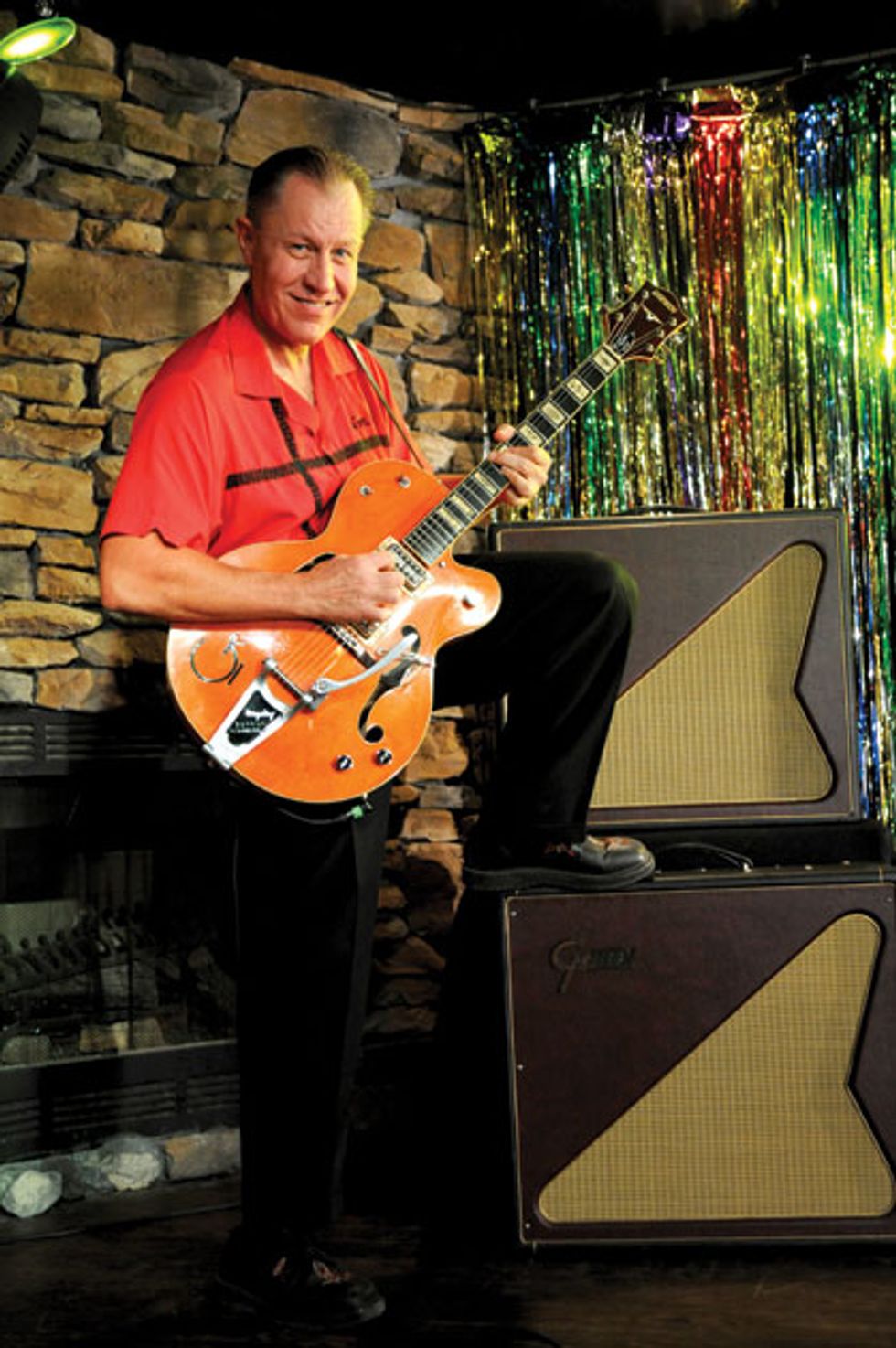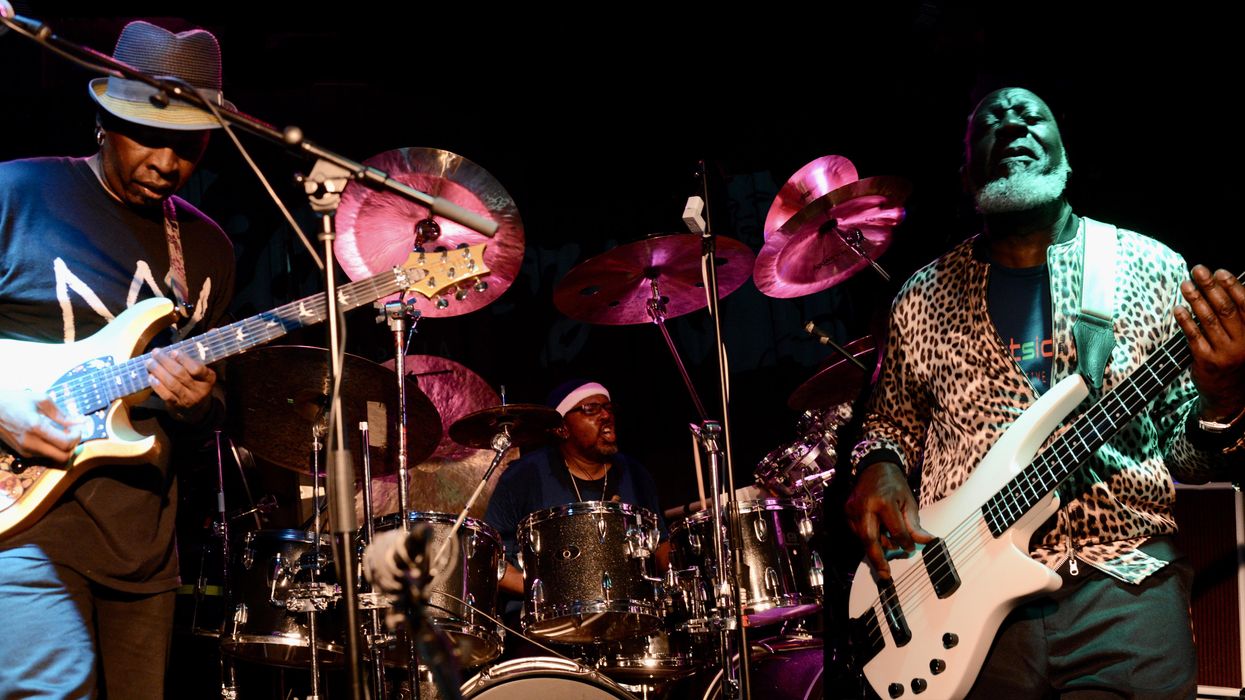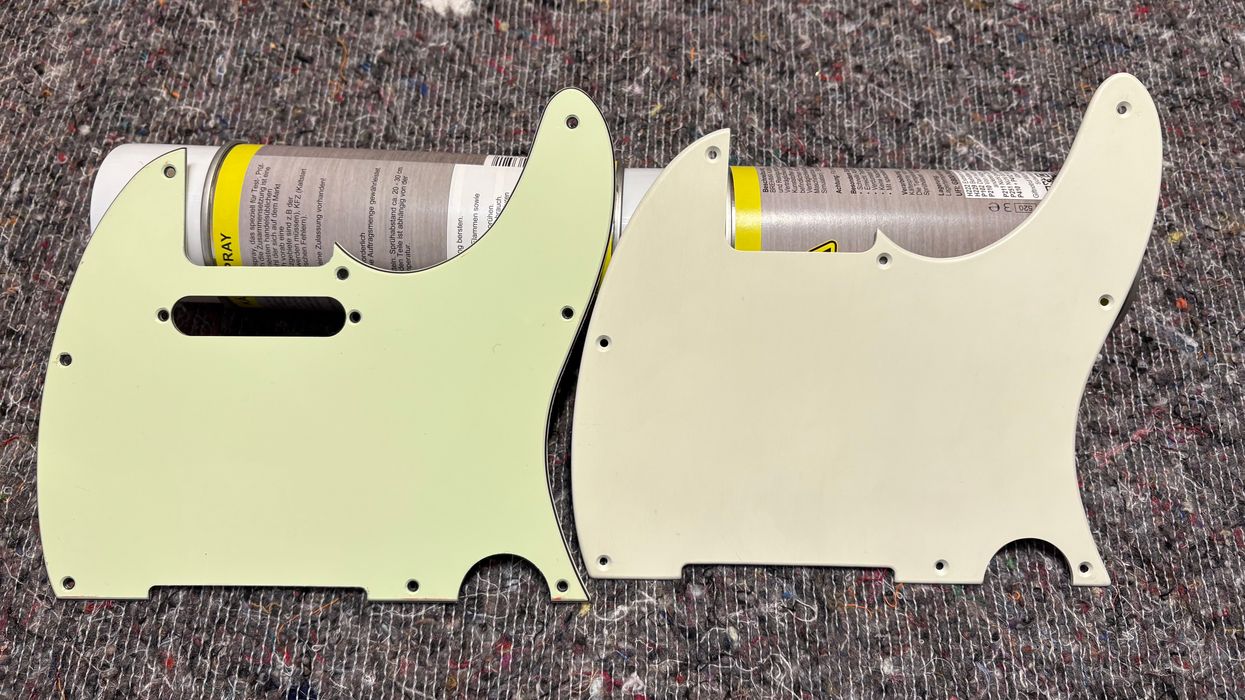With a music video featuring Bettie Page-esque pin-up girls salaciously caressing hot dogs and bananas and lyrics referencing the fine art of “choking the chicken,” Reverend Horton Heat’s “Let Me Teach You How to Eat” is meant to arouse more than just epicures. The song’s origins were innocent—but in the sinister mind of the Reverend, aka Jim Heath, things got twisted.
“The guy [Russell David Hobbs] who actually gave me the name Reverend Horton Heat is a Bohemian-esque guru who had a bar called the Prophet Bar,” says Heath. “He got on this macrobiotic eating kick. One day he asked, ‘What did you eat today?’ I said, ‘I went to the Gold Rush and had whatever.’ He said, ‘Jim, let me teach you how to eat,’ and started taking about all these crazy new age foods. I thought to myself, ‘If I didn’t know how to eat already, I’d be dead.’ But I turned that into a song about sex.”
Unlike the Reverend’s last album, the country-tinged Laughin’ & Cryin’ with the Reverend Horton Heat, his new release, Rev, is the sort of high-octane romp that fans have turned out in droves for since the day almost 30 years ago when Hobbs booked a gig for Heath, who was working as a tech setting up PAs and loading gear for bands like Hüsker Dü and the Replacements.
“I said, ‘I’m not going to do this,’” recalls Heath. “But little did I know he’d already put out flyers and listed it in the paper. There were actually 30 or 40 people at the first gig I ever played, and after the first set they came up and said, ‘Wow, Reverend, that was really great.’ I was so astonished and ecstatic that my songs had reached people that I would have gone with anything. I was desperate at that point. I was living in a warehouse with rats and roaches. So I ran with the whole Reverend thing.”
And run he did, forging an illustrious career spanning 11 studio albums and movie soundtracks like Ace Ventura: When Nature Calls and The Flintstones in Viva Rock Vegas, as well as video games like Guitar Hero 2 and Tony Hawk’s Pro Skater 3. Ostensibly a rockabilly musician, Heath has defied labels from day one, and has shared the bill with acts ranging from the Sex Pistols to Marilyn Manson to Nine Inch Nails.
Playing live is what keeps Heath revved up. “A recording is just one little place in time,” he says. “But music is about a streaming thing—it’s not a painting on the wall. Once you play these riffs, they’re gone forever. Having a crowd to breathe off of is what makes music happen. If I play a solo and the crowd goes crazy, all of a sudden I’m inspired, and I’ll really start kicking ass.”
Rev seems to bring back the more aggressive side of your musical persona.
We like to play fast, high-energy rock ’n’ roll shows, so Rev is us getting back to that. The album prior to this really leaned to country, so I had in my mind that this one would get back to uptempo and aggressive rockabilly songs—a little edgier. I’d always wanted to do a country album, and that was fun. But frankly, it didn’t really get us much. The new country crowd isn’t really into the old traditional country that I like.
When you toured in support of the country album, how was the reaction?
It went over well. Here’s the thing: Every album we've done has a country song. Even one of our crazier albums, Liquor in the Front,had one called “Liquor, Beer, and Wine” that’s still one of our most requested songs. For a band that’s been around as long as we have, it can be tough when we play live, because our fans are paying good money for tickets and they want to hear the songs that they love and remember from our past albums. When we come out with a new album, we have to be very careful about not blowing in too many of the new songs, though it would be fun if we could just go out there and play the whole new album.
Are you the band’s main writer?
I write the songs, then I take them to the guys and we work up arrangements. Sometimes I get the guys involved in the writing. Jimbo [Wallace, bassist] and I co-wrote one of the songs on the album, but with the exception of that, it was all me.
Like many of your songs, “Scenery Going By” has some nice, pungent dissonance. Where does this harmonic fluency come from?
Thanks, man. I appreciate that. I tried to study. I worked with music theory books I’d pick up here and there and I took some courses, but not a lot. No matter what anybody says, a background in music theory is always going to help you. You can still noodle around as if you didn’t ever study music theory. But knowing music theory, you know why it works. I think I’ve managed to hit upon a few chord patterns and shapes that I don’t think I’ve ever heard anybody do before.
Although your show has a fun vibe, you often play intricate runs. How do you manage to pull that off while doing your stage antics?
I’ve been doing this for so long that it becomes second nature. I have to be careful though. There’s a Chet Atkins song off our last album called, “Oh By Jingo!” that is really difficult, especially since I play with hybrid style using a flatpick. Chet Atkins didn’t do that—he used a thumbpick and played with his first and second fingers. If I’m playing it live onstage and start hamming it up, all of a sudden there are a lot of clunkers. [Laughs.]
You’ve reached a new audience with the placement of “Psychobilly Freakout” on Guitar Hero 2. But is it true that you take offense at the psychobilly label?
Well, I don’t consider us to be psychobilly. In the late ’70s bands like the Meteors, Guana Batz, and Demented Are Go fused rockabilly with punk rock. Around 1988 I wrote the song “Psychobilly Freakout,” so before long I was labeled as psychobilly. We do psychobilly festivals and a lot of shows with psychobilly bands, and I’m grateful that that crowd accepts us.
Always the showman, the Reverend Horton Heat plays this live rendition of “The Devil’s Chasing Me” with his left hand over the fretboard, starting at 2:30. Yowza!
When designing his signature Gretsch 6120 model, Jim “Rev” Heath opted for locking tuning keys for faster string changes when working with a Bigsby tremolo.
To set the record straight, how would you classify your music?
When I have to explain it, like when I’m standing next to some guy at the bank or at the grocery store, I tell them that we’re a rock ’n’ roll band influenced by mid-century American music, especially rockabilly.
Is your signature Gretsch your main guitar?
I use my signature Gretsch 6120 RHH 99.9 percent of the time. However, on the new album I used my 1954 Gibson ES-175D on a track called “My Hat.” On “Schizoid,” I used the 6120 RHH and my 1963 Fender Jazzmaster on an additional rhythm track and the solo. I also used the ’63 Jazzmaster on the rhythm guitar track for “Zombie Dumb.”
When you designed your signature model, what personal tweaks did you ask for?
I wanted locking tuning keys because it makes for a way faster string change. If you break a string on something that doesn’t have a Bigsby vibrato arm, you can change strings really fast. The Bigsby is a little slower. You’ve got to bend the string, wrap it around the bottom, and as you feed it through the tuning peg, you have to hold it so it doesn’t pop out of the Bigsby mechanism. You kind of wish you had three hands.
Do you have any special tricks to keep your hollowbody guitars from feeding back?
I don’t do anything. Probably the reason I don’t have a problem is because I don’t use any distortion or boost pedals. I just go straight into the amp and crank it to 10.
Do you keep your guitar at 10 at all times?
The guitar is on 10. The amp is on 10, except on those Gretsch Executives, where I have to back the treble off a bit. The mids, bass, and volume are on 10. If I need to play a little cleaner I can back down with my volume pedal. It works really well. When I back it off just a little bit, it gets a lot cleaner.
If you’re cranking it to 10, it must be really loud.
It’s really loud. It’s valve/tube distortion. Unfortunately, I think that’s lost on a lot of rock ’n’ roll guitar players. I see so many guitar players getting their sound from a stompbox, but it’s so much better to get it from the amp. There’s no way a stompbox will ever get close to valve/tube distortion. You can have stompboxes with tubes, but it’s just not the same as having that amp itself pumping.
Opening with a potent arpeggiated figure that could be straight out of the Stravinsky playbook, Reverend Horton Heat’s “Galaxie 500” is a scorcher. Prepared to be blown away by the pyrotechnics beginning at 1:44.
Reverend Horton Heat’s Gear
Guitars
Gretsch 6120 RHH signature model, 1954 Gibson ES-175D, 1963 Fender Jazzmaster
Amps
Gretsch 6163 Executive, Fender 1978 Super Reverb
Effects
Chandler Stereo Digital Echo, Way Huge Aqua-Puss analog delay, Boss BD-2 Blues Driver, Dunlop DVP-1 volume pedal
Strings, Picks, and Accessories
Dunlop .010–.046 strings, Dunlop Delrin 1.5 mm pick, Mogami cables
How can you crank the amp that loud for so long and not go deaf?
Well, I had that issue for a long time. It got to the point where I eventually built myself a big, soft baffle like a fireplace shroud. I can completely cover my amp if it’s too much. People always talk about the “volume knob.” But when you turn your guitar down from 10 to 8, you’re not just adjusting volume. You’re adjusting the whole tone—the whole treble and bass response, the whole distortion breakup level, and everything. With the baffle, my sound is there. If I’m not hearing it well, instead of adjusting the volume, I can just use my foot to move that baffle, even in the middle of a solo.
You recently switched from a silverface Fender Super Reverb to a Gretsch amp.
Yeah, the new album has the 20-watt Gretsch Executive. My amp is almost more important to my sound than my guitar. What I gravitate toward in any amp is what is easiest to manipulate. If I’m playing along and it seems like it’s okay, but then when I get up to the high notes it sounds a little dull or cloudy, then all of a sudden I’m digging in and having to play too hard. That Super Reverb was the main amp I used for a long time. I have several of them, but the one I liked a lot was the ’78.
After playing a Super Reverb, I’d imagine a 20-watt amp might break up too easily for you.
It’s not that different. To me, the Grestch sounds just like my Super Reverb, except the high notes are easier to manipulate for some reason. I don’t have to dig in as hard to make them come out and be even with the other notes on the fingerboard. What’s weird is that even though the amp has one 15" speaker, my high notes have more clarity than with the four 10" speakers in the Super Reverb.
Is your ’78 Super Reverb one of the 70-watt ultra-linear master volume models that “amp experts” warn players to avoid?
I tell you what: A lot of people talk about equipment, and a lot of those people don’t know crap about what is real. They know this or that, or what they heard—what’s been said before. They also don’t get the silverface at all. They say, “Get the pre-CBS blackface.” Listen, I have a blackface and several silverface Super Reverbs, and they’re all different. I’ve tried so many different amps and so many different Super Reverbs, and I always came back to that ’78. I don’t use it now except for limited studio stuff, but I’ll never sell it.
With your previous rig, you were also going stereo with a Twin Reverb. Is that still the same setup with the Gretsch Executive?
I don’t use the Twin Reverb for anything anymore. That was an experiment gone wrong. I would go through the Twin set at a really low volume with a Boss Blues Driver as a distortion pedal on certain gigs if I needed a little more punch. It was never my sound. My Super Reverb would always be blaring loud, and that was what you’d hear.
Many people assumed that the Twin was an integral part of your sound.
People would see the blackface Twin Reverb onstage because it was the one that didn’t need a baffle. I still have the baffle with the Gretsch amp, but it doesn't cover up the whole speaker. It’s fun talking about this. Most people don’t ask about all this stuff but I guess it’s because you’re from Premier Guitar.
















![Rig Rundown: Russian Circles’ Mike Sullivan [2025]](https://www.premierguitar.com/media-library/youtube.jpg?id=62303631&width=1245&height=700&quality=70&coordinates=0%2C0%2C0%2C0)
















![Rig Rundown: AFI [2025]](https://www.premierguitar.com/media-library/youtube.jpg?id=62064741&width=1245&height=700&quality=70&coordinates=0%2C0%2C0%2C0)




















 Zach loves his Sovtek Mig 60 head, which he plays through a cab he built himself at a pipe-organ shop in Denver. Every glue joint is lined with thin leather for maximum air tightness, and it’s stocked with Celestion G12M Greenback speakers.
Zach loves his Sovtek Mig 60 head, which he plays through a cab he built himself at a pipe-organ shop in Denver. Every glue joint is lined with thin leather for maximum air tightness, and it’s stocked with Celestion G12M Greenback speakers.






